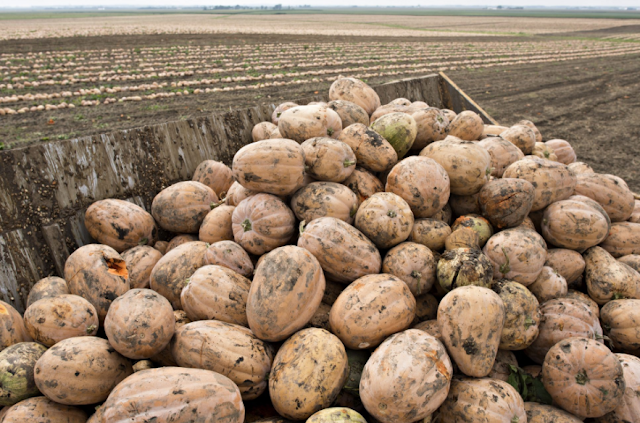It's time to set the record straight.
In a 2016 story titled "I Just Found Out Canned Pumpkin Isn't Pumpkin At All, And My Whole Life is Basically a Lie," a writer with our sister publication MyRecipes spelled out how she believed canned pumpkin was actually squash, not pumpkin. The story, which also appeared on allrecipes.com, spread like wildfire, igniting outraged cooks in all corners of the country — for good reason. We've all believed our precious cans of pumpkin puree come from magical fields of orange gourds that bask in the sun until they're ripe for the picking.
But there's just one problem with that story: It is not exactly true.
Canned pumpkin is pumpkin, but it's not the type of pumpkin you are likely imagining when you pluck a few cans off the shelf for your next pumpkin bread baking session. And to be fair to our culinary imaginations, the cans often show illustrations of the classic jack-o'-lantern pumpkins, also known as field pumpkins.
Instead, most canned pumpkin in the U.S. is made from a type of pumpkin that doesn't look all that typical. Dickinson pumpkins, also known as Dickinson squash, are the pumpkins used to make the majority of canned pumpkin we eat today. But Dickinson pumpkins are tan pumpkins with uniform, smooth skin that are much larger than the average field pumpkin. They're also sometimes called squash, not pumpkins.
What's more, their taste is nothing like a field pumpkin — which is actually a very good thing. Field pumpkins are not at all delicious. The flesh is watery and stringy, and even with roasting, you aren't going to get a lot of flavor, certainly not what you would expect from a pumpkin pie or pumpkin cheesecake.
Libby's — the company that makes more than 80 percent of canned pumpkin in the U.S. — has their own pumpkin variety, Libby's Special Seed, which is derived from the Dickinson pumpkin, and 100 percent of the pumpkin they use in the cans of pumpkin they manufacture in their Morton, Ill. headquarters comes from these pumpkins.
So why is it that some people think canned pumpkin isn't pumpkin? It comes down to the definition of pumpkin.
In 1957, the U.S. Food and Drug Administration (FDA) set out a definition for canned pumpkin and canned squash that, unlike the poodle skirt, has stood the test of time: "Canned pumpkin and canned squash is the canned product prepared from clean, sound, properly matured, golden fleshed, firm shelled, sweet varieties of either pumpkins or squashes by washing, stemming, cutting, steaming and reducing to a pulp."
In other words, the distinction between what you can call a pumpkin and what you can call a squash is fuzzy. So what one person calls a squash is another person's pumpkin, and really, neither person is wrong.
Further, Dickinson pumpkins, part of the Cucurbita moschata species, are closely related to butternut squash. Field pumpkins are part of the Cucurbita pepo species. So someone reading that may assume that the Dickinson pumpkin is more squash than pumpkin. But other members of that species family include the cantaloupe and cucumbers, and you'd never mistake them for a squash.
Some botanists insist only the pepo species can be called pumpkins, while other resources (including Britannica and Merriam-Webster) say both species are part of the pumpkin family. Pumpkin purists would quibble with their open-minded approach to the definition.
Unfortunately, the FDA's definition has never been updated or clarified to really say what a squash is and what a pumpkin is. That means some squash, like the Dickinson pumpkin, are called both — and sometimes, the label reflects that definition issue.
Yes, some pumpkin canners could be using a mix of pumpkin and squash in their canned pumpkin. But if the label says 100 percent pumpkin, it is pumpkin — it's just not the classic orange pumpkin you're imagining. And that's a good thing.
